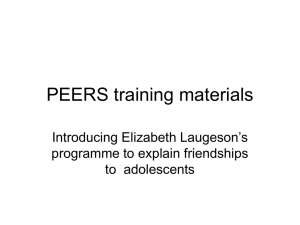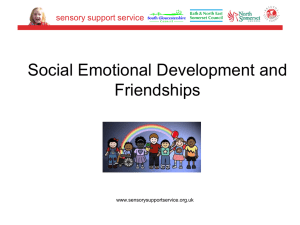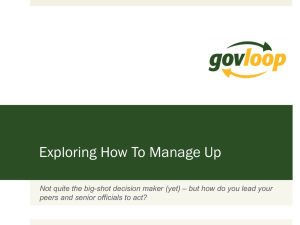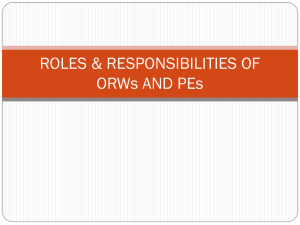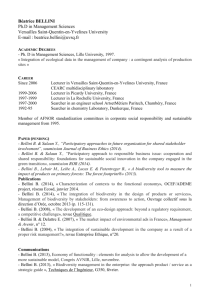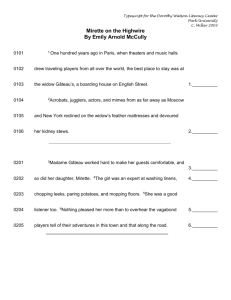Social Skills - FDLRSStructuredClassroom
advertisement
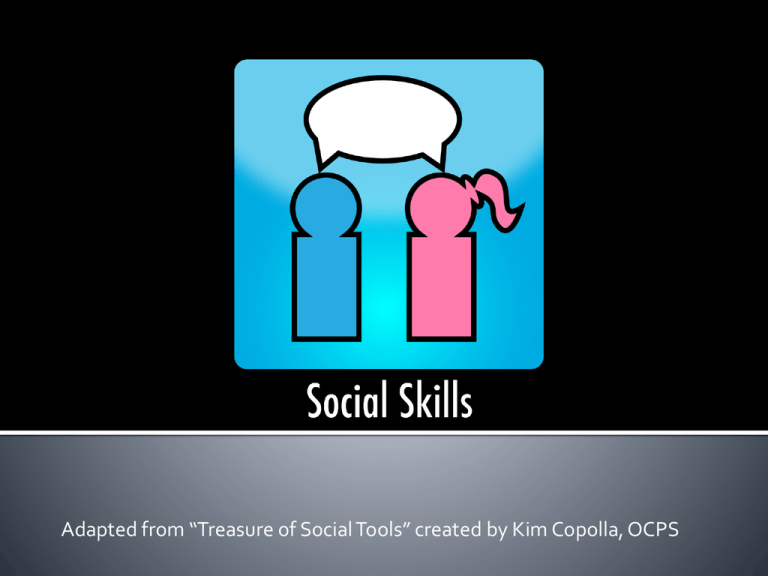
Adapted from “Treasure of Social Tools” created by Kim Copolla, OCPS “I am not asking for my child to be the life of the party, or a social butterfly. I just want her to be happy and have some friends of her own. She is a wonderful kid, and I hope some day others can see that.” ALL students want to establish meaningful social relationships If we want children and adolescents to be successful socially, we must teach them the skills to be successful Successful social behaviors are not always appropriate social behaviors. Social success is dependent upon our ability to adapt to our environment Social interaction skills are not the equivalent of academic skills Scott Bellini, 2006 Scott Bellini “Socially acceptable learned behaviors that enable a person to interact with others in ways that elicit positive responses and assist the person in avoiding negative responses. (Elliott, Racine, & Busse, 1995) Social interaction skills are the building blocks of successful social relationships. (Bellini, 2006) The purpose of social skills is to facilitate positive interactions with peers. Bellini (2006) pgs. 1-9 3 Integrated Components THINKING • Social Interaction depends on all 3 components. • Difficullties in any of the 3 components can lead to impairment in social functioning • They work together to: - promote or hinder successful social interactions DOING FEELING Bellini (2008) pgs. 19-34 Nonverbal Communication Social Interaction Reciprocity and Terminating Interaction Social Cognition Behavior Associated with Perspective Taking and Self Awareness Social Anxiety and Social Withdrawal •Recognizes the facial expressions of others •Maintains eye contact during conversations •Has facial expressions that are congruent with emotion •Recognizes the meaning behind the tone of another person’s voice •Recognizes the nonverbal cues of body language of others •Uses gestures to communicate needs correctly interprets the emotions of others •Demonstrates a wide range of facial expressions •Modulates the tone of his/her voice •Join in activities with peers •Asks questions to request information about a person •Invites peers to join into activities •Joins a conversation with two or more people without •Demonstrate proper timing interrupting with social initiations •Initiates greetings with •Asks questions to request others information about a topic •Introduces self to others •Takes turns during a game •Responds to greetings of others •Allows peers to join in activities •Ends conversations appropriately •Maintains the give and take of a conversation •Acknowledges compliments directed at him/her by others •Responds to the invitations of peers to join in to activities •Reads cues to terminate conversations • Compromises during disagreements with others •Correctly analyzes social situations •Responds promptly in conversations •Understands the jokes or humor of others •Talks about topics that other people find interesting •Considers multiple viewpoints •Avoid being manipulated by peers •Correctly interprets the intentions of others •Maintains personal hygiene •Expresses sympathy for others Maintains an appropriate distance when interacting with peers •Talks about or acknowledges the interests to others Speaks wit an appropriate volume in conversations •Provides compliments to others Refrains from making inappropriate comments Offers assistance to others •Interacts with peers during unstructured activities •Interacts with peers in large group situations •Interacts with peers during structured activities •Attempts to interact with unfamiliar peers •Engages in one on one social •Experiences positive peer interactions with peers interactions •Engages in positive self-talk Assess Social Functioning Distinguish Between Skill Acquisition and Performance Deficits Select Intervention Strategies 1. 2. 3. 4. 5. Strategies That Promote Skill Acquisition Strategies that Enhance Performance Implement Intervention Evaluate and Monitor Progress Commercial Teacher made Observations Interviews Rating Scales Books with Assessment Tools Built In: Assessment Tools for Social Skills: http://www.linguisystems.com/ http://www.superduperinc.com *** THESE ASSESSMENTS CAN BE DONE ONE ON ONE OR WHOLE GROUP **** *** THESE ASSESSMENTS CAN BE DONE ONE ON ONE OR WHOLE GROUP **** Skill Acquisition Difficulty: The person does not possess the skill and can not successfully perform the skill Performance Difficulty: The person has the skill but does not perform the skill. Promote Skill Acquisition Enhance Social Performance Thoughts, feelings and Interest Activities Reinforcement/Contingency Strategies Reciprocal Intervention Strategies Gaming Skills Social Stories Environmental Modifications Role Playing Peer Mediated Instruction Video Modeling Increased Social Opportunities/Live Practice Social Problem Solving and Social Rules Disability Awareness Self Monitoring Self Monitoring Relaxation Techniques and Emotional Regulation Relaxation Techniques and Emotional Regulation Prompting Strategies Prompting Strategies Interaction/Conversation Planning Video Modeling/Social Stories Check it out! Non-Verbal Teaching Activities “WATCH AND IDENTIFY” Using both live and video model Emotion Charades- Basic Level Your dog died. How do you feel? “REACT TO A SITUATION” Students role-play a situation Emotion Charades- Advanced Level Use cartoons to teach emotions Capitalize on the child’s “likes” and “preferences” Check it out! A Social Story presents social concepts and rules to students in the form of a brief story. Written in response to the child’s personal need Something the student wants to read on own Match with student’s ability and comprehension Use less directive terms such as “can” or “could”, instead of “will or “must”. Gray, 1995, 2000 Check it out! Video modeling intervention involves watching a video demonstration and then imitating the behavior of the model Incorporates visual learning Increases attention Decreases anxiety Increases motivation Increases self-awareness Great examples of nonverbal body language Examples of figurative language and nonverbal body language Examples of for all deficit areas Idea taken from Jill Kuzma http://jillkuzma.wordpress.com Examples: Hidden Curriculum Calendar: Items for Understanding Unstated Rules in Social Situations by Brenda Smith Myles and Megan Duncan • Don’t argue with a policeman even if you are right. • Don’t tell someone they are fat when they are • Don’t point out other people’s mistakes • Don’t insist that other people follow the rules • Male bathroom rule “The ball is in your court” We have them for all settings Not the same for all settings When we exhibit expected behaviors people have “good thoughts” about us When we exhibit unexpected behaviors people have “weird thoughts” about us These thoughts impact the way Check others treat us it out! Michelle Garcia Winner Thinking and Saying Thoughts Okay Caution No Green thoughts are good thoughts. These are thoughts that you can think in your head and say without offending someone. Yellow thoughts are caution thoughts. These are thoughts that you can think in your head but use caution when you say them. These are thoughts that are okay to say to some people but not okay to say to other people. Red thoughts are thoughts that you should not say out loud. These are thoughts you can think in your head but not say. Red thoughts usually offend people when you say them out loud. Check it out! It is a self regulation tool that can assist a person in learning how to think about and understand their emotional responses to a situation. 1. Need to have concept that can be broken into 5 parts. 2. Use a story/social story to teach the 5 parts of the concept. - can be positive or negative 3. Create a scale www.5pointscale.com A volume scale A miniature scale for the back of ID badge Modified from Kari Dunn Baron’s book: ‘A 5 Could Make Me Lose Control’ Modified from Kari Dunn Baron’s book: ‘A 5 Could Make Me Lose Control’ Promote Skill Acquisition Enhance Social Performance Thoughts, feelings and Interest Activities Reinforcement/Contingency Strategies Reciprocal Intervention Strategies Gaming Skills Social Stories Environmental Modifications Role Playing Peer Mediated Instruction Video Modeling Increased Social Opportunities/Live Practice Social Problem Solving and Social Rules Disability Awareness Self Monitoring Self Monitoring Relaxation Techniques and Emotional Regulation Relaxation Techniques and Emotional Regulation Prompting Strategies Prompting Strategies Interaction/Conversation Planning Video Modeling/Social Stories Consider…………… Individual Group Classwide Self-contained class Natural environment General education setting Include peers without disabilities Progress monitoring Observations Structured Natural setting Interviews Rating scales Assess Social Functioning Distinguish Between Skill Acquisition and Performance Deficits Select Intervention Strategies Strategies That Promote Skill Acquisition Strategies that Enhance Performance Implement Intervention Evaluate and Monitor Progress Check it out!
